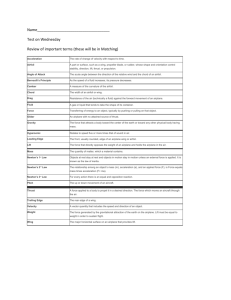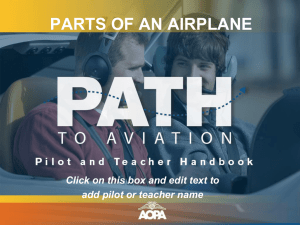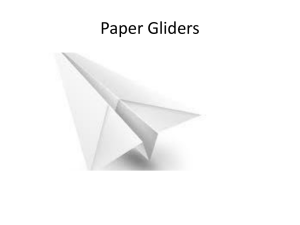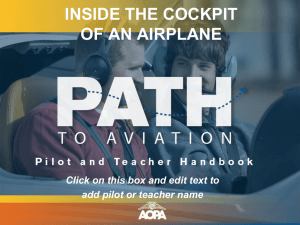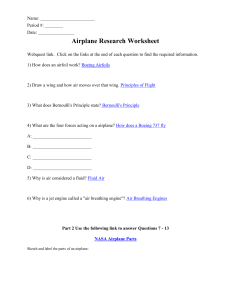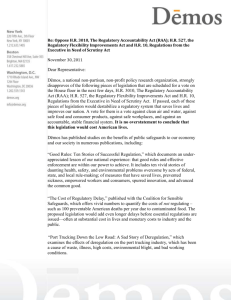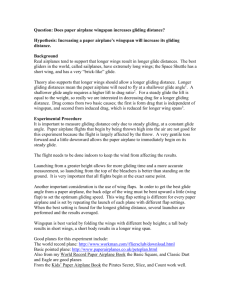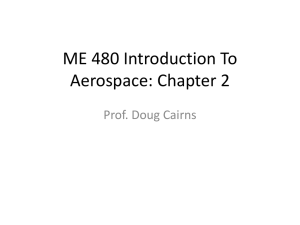Boeing Commercial Weight Engineering and the 787 Program
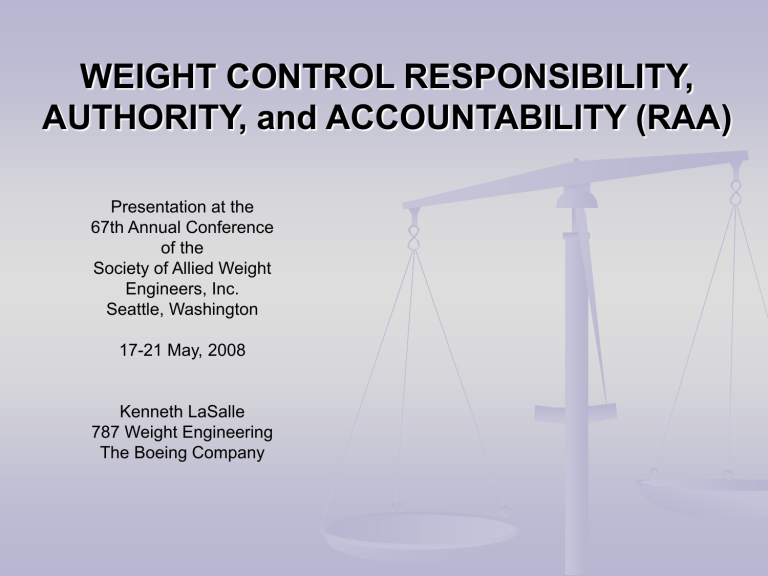
WEIGHT CONTROL RESPONSIBILITY,
AUTHORITY, and ACCOUNTABILITY (RAA)
Presentation at the
67th Annual Conference of the
Society of Allied Weight
Engineers, Inc.
Seattle, Washington
17-21 May, 2008
Kenneth LaSalle
787 Weight Engineering
The Boeing Company
Weight Control RAA
Agenda
Importance of Weight Control
Weight Derivation Ingredients
Roles & Responsibilities
Weight Control Engineering Attribute Overview
Summary
Weight Control RAA
Q: Why is weight efficiency important to airlines?
A: Weight affects 2/3 of the airplane operating cost
Weight Control RAA
How is the airplane weight, at Entry Into Service, derived & improved through design process
(structural perspective)?
Product Development
“Design Sensitive”
Tools/Parametrics
Firm Concept
Parametrics +
LCPT Initial Sizing
Detail Design
Fully Released MBDs
/ Actual Weights
Weight = f
Configuration + Aerodynamics + Loads + Stress + Design
• Mission req’ts • Airfoil Type • External • Strength • Producibility
• 3-View • Sweep • Preliminary • Fatigue • Layouts
• Planform • T/c • Design • Stiffness • Ply maps
• Integration • Aspect ratio • MLA • Criteria • Buy to Fly
• Functionality • Span • Internal • Min Gage • Detailed Part Modeling
• New Technology • Etc.
• Thermal • MS • Integration
• Etc.
• Combined • Etc.
• Noise
• Etc.
• Design Growth
• Etc.
Weight is the result of the released design. To influence the airplane weight, the weight control engineer must influence the design process.
Weight Control RAA
Roles and Responsibilities (or RAA)
Ensure the weight efficiency & weight compliance of our company’s products
Provide airplane weight estimates given “any” level of design definition
Documented weight estimations w/all assumptions defined
Articulate differences between new design concept and existing fleet
Proactive design influence (must integrate ourselves into the design community)
Lead airplane weight optimization effort (New, Derivative, or Sustaining)
Company leadership’s “primary” resource for weight efficient project planning
Provide technology & weight optimization roadmap (Chart the course w/ R&D Team)
Lead weight reduction planning activities (Idea collection thru implementation)
Required Weight Control Engineering Attributes
Big Picture / Vision / Strategy Focus
Teamwork
Technical Competence
Personal Attitude / Challenge / Development
Big Picture / Vision / Strategy
Commercial Airplane Business Unit (Investment in enhanced performance?)
Conditions affecting airlines
High fuel prices?
Passenger expectations (more comfort or direct flights)
Company fleet condition (aging or gaps in family?)
Launched Programs (competing resources)
787 Family, 777 Freighter, 747-8
A380, A350
Airplane Performance Organization (How Do We Balance Risk?)
Engine Performance (SFC) vs. Weight (OEW) vs. Aero Performance (L/D)
Weight Engineering Organization
Communicate frequently to the design team
What is the airplane weight level (understand all assumptions)
Where the airplane level is going (forecasting)
Why we are pursuing target weight level
How we are going to achieve target weight level
Teamwork
(Establish Trust & Dependability)
Establish Network
Leadership (First-line to program level)
Configuration & Engineering Analysis (C&EA)
Design
Stress
Loads
Manufacturing
Finance
Global Supplier(s)
Build Relationships… More than just requesting information
Provide Data
On time (meet commitments)
Accurate (fidelity required, list & discuss all assumptions)
Team Player
Ask trade study team to request missing disciplines’ participation
Represent airplane level interests, not just Weight Engineering
Technical Competence
Determine Mission Requirement Design Impacts
Range (wing planform & loft size, fuel capacity, low speed devices)
Passenger count (fuselage length & diameter, wing center section width)
Passenger Accommodations (higher humidity, lower cabin alt pressure, large windows)
Speed (wing sweep, airfoil depth, etc.)
Take off & landing performance (i.e. icy runway conditions, field length)
Family plan (weight impacts due to commonality)
Interior architecture (New vs. Derivative vs. Existing Fleet)
Interior flexibility impacts
Overhead space utilization (Crew rest compartments, OCAS, etc.)
Option strategy (what to make basic vs. options)
Cost (NR & Recurring)
Noise - Environmental & Passenger
Maintenance and reliability enhancements
Aviation authority requirements (FAA or EASA)
Entry into service goal
Technical Competence
Understand Schedule & Key Design Gates
Weight Reduction Opportunity
1000’s of pounds
Product Development
Firm Concept
Systems Architecture
Initial Loads
Preliminary Loads
Aerodynamic Lines Freeze
Firm Configuration
Firm Interior Architecture
Detail Design Phase
Final Loads
Flight Testing
Entry Into Service (EIS)
10’s of pounds
Technical Competence
Understand Work Package Definition
Structures– Ensure clear understanding of:
Part-level definition
Primary vs. secondary structure
Integration structure (splices, sealant, fastener type & size, etc.)
Attachments (composite – bolts in lieu of rivets)
Interfaces (systems to structures, eccentricities, etc.)
Systems – Ensure clear understanding of:
Systems architecture definition (fuel, high lift, hydraulic, electrical, etc.)
Systems separation
Bomb blast
Engine/APU blade off/rotor burst
Loads (determine which ones are critical, how close is next condition)
External (static – 2.5G flaps down, dynamic – gust)
Internal (buckling, combined loading, thermal, etc.)
Systems (fan blade out, voltage, heat, power, , flow, rpms, psi, etc.)
Materials
Allowables (A-basis vs. B-basis, criteria effects, etc.)
Density (areal weight, density, etc.)
Sizing criteria (choose most efficient material, i.e., for fatigue or strength or durability)
Application (CFRP… ply orientation/optimization, etc.)
Cost (Titanium vs. Aluminum)
Technical Competence
Understand Weight, Cost, Schedule Relationship
Determine significant technical weight drivers
Material selection
Planform (Wing & Empennage)
Body cross-section
Airfoil technology
High lift systems
Load alleviation
Architecture
Integration
Supplier base
System’s performance requirements (Temp, flow, power, pressure, etc.)
Determine large cost drivers (typically compete with large weight drivers)
Advanced materials (procurement cost, manufacturing, etc.)
Advanced build technology (new facilities, tooling, etc.)
New Technology (high-pressure hydraulics, fiber optics, advanced magnetics, etc.)
Balance weight vs. performance vs. cost vs. schedule
Technical Competence
Ask Questions / Challenge Decisions
Ask questions & compare existing fleet data
What requirements and objectives guide the design?
What advisories are circulating that affect the design?
Study or create “Tops Down” charts to compare fleet data
Challenge decisions and criteria
Requirements
Commonality designs
Material selections
Production Constraints
Inspectable
Preferred materials and standard parts
Handling constraints (envelope, weight, robustness)
Assembly techniques & tooling
Architectural or layout arrangement
Loads, stress and design assumptions (Conservative?)
Provide Feedback
Positive & negative
Say “thank you”
Personal Attitude/Challenge/Development
Having a positive and optimistic outlook and approach enables:
Strong design team working relationships - trust, integrity, ethics
More cross-functional participation resulting in accumulation of known and unknown information
Mentoring & friendship opportunities
Developing weight control attributes takes repetition working through new designs
Learning to be inquisitive, while providing appropriate support, is necessary
Communication skills are an essential asset
Implementation of short- and long-term career development plans needs to occur early
Summary
Weight Engineering is a diverse and technical field
Weight control engineering is proactive
Roles and responsibilities change as program progresses through design cycle
Communication, both verbal and written, are key
It takes a lengthy period to become an adept weight control engineer
